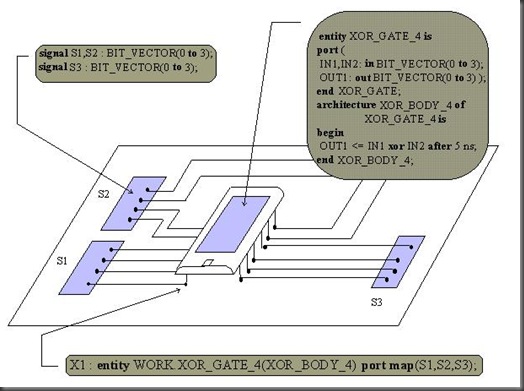Formal Definition
A component instantiation statement defines a subcomponent of the design entity in which it appears, associates signals or values with the ports of that subcomponent, and associates values with generics of that subcomponent.
Simplified Syntax
label : [ component ] component_name
generic map ( generic_association_list )
port map ( port_association_list );
label : entity entity_name [(architecture_identifier)]
generic map ( generic_association_list )
port map ( port_association_list );
label : configuration configuration_name
generic map ( generic_association_list )
port map ( port_association_list );
Description
A component represents an entity/architecture pair. It specifies a subsystem, which can be instantiated in another architecture, leading to a hierarchical specification. Component instantiation is like plugging a hardware component into a socket in a board (Fig. 1 in Example 1).
The component instantiation statement introduces a subsystem declared elsewhere, either as a component or as an entity/architecture pair (without declaring it as a component).
The component instantiation contains a reference to the instantiated unit and actual values for generics and ports. There are three forms of component instantiation:
· instantiation of a component;
· instantiation of a design entity;
· instantiation of a configuration;
See configuration for details on the third form.
The actual values of generic map aspect and port map aspect connections allow assigning the components of the actual values to generic parameters and ports.
INSTANTIATION OF A COMPONENT
Instantiation of a component introduces a relationship to a unit defined earlier as a component (see component declaration). The name of the instantiated component must match the name of the declared component. The instantiated component is called with the actual parameters for generics and ports. The association list can be either positional or named.
In the positional association list, the actual parameters (generics and ports) are connected in the same order in which ports were declared in the component (Example 1).
Named association allows to list the generics and ports in an order that is different from the one declared for the component. In such a case the ports have to be explicitly referenced (Example 2).
INSTANTIATION OF A DESIGN ENTITY
It is not necessary to define a component to instantiate it: the entity/architecture pair can be instantiated directly. In such a direct instantiation, the component instantiation statement contains the design entity name and optionally the name of the architecture to be used for this design entity. The reserved word entity follows the declaration of this type of the component instantiation statement (Example 3).
If architecture name is not specified in an instantiation of a design entity, the last compiled architecture associated with the entity will be taken.
Examples
Example 1
architecture Structural of ALU is
signal X,Y,S,C : bit;
component HalfAdder is
port (In1, In2 : in bit;
Sum, Carry : out bit);
end component HalfAdder;
begin
HA : HalfAdder port map (X,Y,S,C);
. . .
end architecture Structural;
The structural specification of an arithmetic-logic unit ALU uses an instantiation of a HalfAdder component. Note that the component is instantiated with signals of the ALU system. The signals are associated positionally.
Example 2
architecture Structural of ALU is
signal X,Y,S,C : bit;
component HalfAdder is
port (In1, In2 : in bit;
Sum, Carry : out bit);
end component HalfAdder;
begin
HA : HalfAdder port map (Sum=>S, Carry=>C,
In1=>X, In2=>Y);
. . .
end architecture Structural;
This structural architecture performs the same function as in the Example 1. The only difference lies in the way the association list is specified for the component ports - the signals are associated with named association.
Example 3
entity XOR_GATE_4 is
port(IN1,IN2: in BIT_VECTOR(0 to 3);
OUT1 : out BIT_VECTOR(0 to 3));
end entity XOR_GATE_4;
architecture XOR_BODY_4 of XOR_GATE_4 is
begin
OUT1 <= IN1 xor IN2 after 5 ns;
end architecture XOR_BODY_4;
entity EXAMPLE is
end entity EXAMPLE;
architecture STRUCTURE_1 of EXAMPLE is
signal S1,S2 : BIT_VECTOR(0 to 3);
signal S3 : BIT_VECTOR(0 to 3);
begin
X1 : entity WORK.XOR_GATE_4(XOR_BODY_4)
port map (S1,S2,S3);
end architecture STRUCTURE_1;
Entity XOR_GATE_4 is directly instantiated here, without declaring a component. The architecture, which specifies the body of the entity XOR_GATE_4 is called XOR_BODY_4 and is supported in parentheses. Further specification is similar to the one in instantiation of a component. The entity and architecture instantiated here must be located in the WORK library prior to this instantiation.
Figure 1. Example of a direct instantiation.
Important Notes
· The label for component instantiation is obligatory.




No comments:
Post a Comment
Please provide valuable comments and suggestions for our motivation. Feel free to write down any query if you have regarding this post.